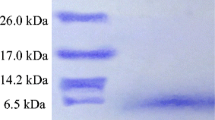Abstract
The Lactococcus lactis subsp. lactis 194-K strain has been established to be able to produce two bacteriocins, one of which was identified as the known lantibiotic nisin A, and the other 194-D bacteriocin represents a polypeptide with a 2589-Da molecular mass and comprises 20 amino acid residues. Both bacteriocins were produced in varying proportions in all of the studied culture media, which support the growth of the producer. Depending on the cultivation medium, the nisin A content was 380- to 1123-fold lower in the 194-K stain culture broth than that of the 194-D peptide. In comparision to nisin A Bacteriocin 194-D possessed a wide range of antibacterial activity and suppressed the growth of both Gram-positive and Gram-negative bacteria. An optimal medium for 194-D bacteriocin synthesis was shown to be a fermentation medium which contained yeast extract, casein hydrolysate, and potassium phosphate. The biosynthesis of bacteriocin 194-D by the 194-K strain in these media occurred parallel to producer growth, and its maximal accumulation in the culture broth was observed at14–20 h of the strain’s growth.
Similar content being viewed by others
References
Hirsh, A., J. Gen. Microbiol., 1951, vol. 5, pp. 208–221.
Delves-Broughton, J., Blackburn, P., Evans, R.J., and Hugenholtz, J., Antonie Leeuwenhoek, 1996, vol. 69, no. 2, pp. 193–202.
Galvez, A., Abriouel, H., Lopez, R., and Omar, N., J. Food Microbiol., 2007, vol. 120, nos 1–2, pp. 51–70.
Nes, I., Yoon, S-S., and Diep, D.B., Food Sci. Biotechnol., 2007, vol. 16, no. 5, pp. 675–690.
Nissen-Meyer, J., Oppegard, C., and Rogne, P., Haugen H.S., Kristiansen E, Probiotics Antimicrob. Prot., 2010, vol. 2, no. 2, pp. 52–60.
Oscariz, J.C. and Pisabarro, A.G., Int. Microbiol., 2001, vol. 4, no. 1, pp. 13–19.
Mantovani, H. and Russell, J., Appl. Environ. Microbiol., 2001, vol. 67, no. 2, pp. 808–813.
Stoyanova, L.G., Sul’timova, T.D., and Netrusov, A.I., Vestn. Mosk. Univ., Ser. Biol., 2003, vol. 16, no. 4, pp. 17–22.
Stoyanova, L.G., Sul’timova, T.D., Botina, S.G., and Netrusov, A.I., Appl. Biochem. Microbiol., 2006, vol. 42, no. 5, pp. 560–568.
Stoyanova, L.G., Ustyugova, E.A., Sultimova, T.D., Bilanenko, E.N., Fedorova, G.B., Khatrukha, G.S., and Netrusov, A.I., Amer. Agricult. Biol. Sci, 2010, vol. 5, no. 4, pp. 477–485.
Ustyugova, E.A., Fedorova, G.B., Katrukha, G.S., and Stoyanova, L.G., Mikrobiologiya, 2011, vol. 80, no. 5, pp. 644–650.
Jensen, P. and Hammer, K., Appl. Environ. Microbiol., 1993, vol. 59, no. 12, pp. 4363–4366.
Stoyanova, L.G. and Levina, N.V., Microbiology, 2006, vol. 75, no. 3, pp. 286–291.
Li, C., Bai, J., Cai, Z., and Ouyang, F., J. Biotechnol., 2002, vol. 93, no. 1, pp. 27–34.
de Man, J.D., Rogosa, M., and Sharpe, M.E., J. Appl. Bacteriol., 1960, vol. 23, no. 1, pp. 130–135.
Zhou, X., Pan, Y-J., Wang, Y.-B., and Li, W.-F., J. Food Sci., 2008, vol. 73, no. 6, pp. 245–249.
Sova, O., Electrophores, 1990, vol. 11, no. 11, pp. 963–966.
Durrum, E.L., Science, 1951, vol. 113, no. 2925, pp. 66–68.
Haese, A. and Keller, U., J. Bacteriol., 1988, vol. 170, no. 3, pp. 1360–1368.
Venema, K., Chikindas, M., Seegers, M., Haandrikman, J., Leenhouts, K.J., Venema, G., and Kok, J., Appl. Environ. Microbiol., 1997, vol. 63, no. 1, pp. 305–309.
Zendo, T., Yoneyama, F., and Sonomoto, K., Appl. Microbiol. Biotechnol., 2010, vol. 88, no. 1, pp. 1–9.
Berdy, J., J. Antibiot., 2005, vol. 58, no. 1, pp. 1–26.
Bostian, M., McNitt, K., Aszalos, A., and Berdy, J., J. Antibiot., 1977, vol. 30, no. 1, pp. 633–634.
Author information
Authors and Affiliations
Corresponding author
Additional information
Original Russian Text © E.A. Ustyugova, A.V. Timofeeva, L.G. Stoyanova, A.I. Netrusov, G.S. Katrukha, 2012, published in Prikladnaya Biokhimiya i Mikrobiologiya, 2012, Vol. 48, No. 6, pp. 618–625.
Rights and permissions
About this article
Cite this article
Ustyugova, E.A., Timofeeva, A.V., Stoyanova, L.G. et al. Characteristics and identification of bacteriocins produced by Lactococcus lactis subsp. lactis 194-K. Appl Biochem Microbiol 48, 557–563 (2012). https://doi.org/10.1134/S0003683812060105
Received:
Published:
Issue Date:
DOI: https://doi.org/10.1134/S0003683812060105




